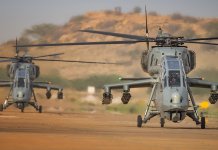With neither of the two neighbours India or China ready to put their sword down, Ladakh continues to become a hotbed for a potential clash of two regional powers. With temperatures dropping to minus 35 degrees Celsius in winters, the freezing temperatures are most likely to become the biggest adversary.
After The Rafale Fiasco, How Will Indian Armed Forces Benefit From The Removal Of Offset Clause?
India’s armed forces have begun preparations for the long haul by stocking up winter supplies including heavy weapons, ammunition, communication equipment, heaters, fuel, food and essential commodities under what would be considered the largest military storage operation for several decades in the region.
The winter months of November up until February has led the forces to generate a massive stocking of ration, winter clothing and high-altitude tents to keep the troops stationed in the region, well equipped in dealing with the Chinese threat if and when it arises.
Russia, China or The US: Which Country’s Air Force Operates The World’s Fastest Fighter Jets?
Indian troops have already been supplied with specialised winter clothing which includes layered jackets and world-class boots which have been imported from several countries in Europe.
An Indian Army official, Major General Arvind Kapur, Chief of Staff 14 Corps based in Leh, while speaking to an Indian publication, India Today, said – “Our logistic infrastructure is smartly built in a manner that any formation coming from outside, in ‘Plug & Play’ mode, can join the units here seamlessly and be effective. Today, each jawan deputed at the frontline has state-of-the-art winter clothing and tentage,”
Shedding light on the thousands of tons of ration transported to the region, he explained how each officer, Junior Commissioned Officer (JCO) and soldiers are provided with the best quality ration, which is highly nutritional and is of high calorific value.
According to military sources cited by Indian media, the massive operation which had begun in the month of July post the Galwan Valley clash has been privately orchestrated by India’s Chief of Army Staff General MM Naravane and a group of top commanders.
Armenia-Azerbaijan Conflict: Why Armenia Needs To Pull-Out From Occupied-Regions Of Azerbaijan: OPED
The report also added that the Indian armed forces conducted the largest logistical campaign after realizing that there was no chance of an early resolution to the border dispute.
With the Indian Army realizing the need to maintain its current strength of troops in all major areas of Eastern Ladakh, three additional army divisions have also been deployed in the region.

The winter stock which is said to last for a year now has all been transported to the region by Indian Air Force’s (IAF) transport aircraft and helicopters which include the Lockheed Martin C-130J Super Hercules, Boeing C-17 Globemaster III and other planes.
“The C17 and Chinook are symbols of jointmanship utilised for heavy military equipment and logistics. The Air Force and Army have been working in synergy and it exemplifies the quick mobility of men and material in these mountainous terrains,” said Air Commodore DP Hirani.
While the IAF has been using its aircraft to make frequent landings at the Leh Airbase to bring in troops and essential supplies to forward locations, it is said to be on high alert in areas along the Line of Actual Control (LAC), with its fighter jets seen flying around the region regularly.
Armenia-Azerbaijan Conflict: Why Armenia Needs To Pull-Out From Occupied-Regions Of Azerbaijan: OPED
Moreover, according to reports, there have been a large number of T-90 and T-72 tanks, canons along with BMP-2 infantry combat vehicles deployed by the Indian Army in several sensitive areas like Chumar, Depsang and Chushul sectors of the Eastern Ladakh region to foil any Chinese advances.
#WATCH Indian Army deploys T-90 & T-72 tanks along with BMP-2 Infantry Combat Vehicles that can operate at temperatures up to minus 40 degree Celsius, near Line of Actual Control in Chumar-Demchok area in Eastern Ladakh.
Note: All visuals cleared by competent authority on ground pic.twitter.com/RiRBv4sMud
— ANI (@ANI) September 27, 2020
The T-90 tanks have deployed to the Depsang plains in sub-sector north (SSN) where the Chinese troops have prevented Indian troops from patrolling in patrol points (PPs) 10-13. All of the tanks deployed by the army can operate at extreme temperatures of even minus 40 degrees Celsius.
Fire and Fury Corps chief of staff Major General Arvind Kapoor, while speaking to a news agency, said – “The Fire and Fury Corps is the only formation of the Indian Army and also in the world to have actually deployed mechanised forces in such harsh terrain. The maintenance of tanks, infantry combat vehicles and heavy guns is a challenge in this terrain. To ensure crew and equipment readiness, adequate arrangements are in place for both man and machine.”
Niti J Ticku, an expert talking to the EurAsian Times said that it is highly likely that it won’t be the much-hyped Rafale fighter jets that will be a game-changer in Ladak as the possibility of a war is highly unlikely, but Indian Air Force’ transport aircraft like C-130J, C-17 Globemaster other transport aircraft and choppers could end up being the real heroes for keeping the Indian soldiers warm and well-nourished & equipped.




